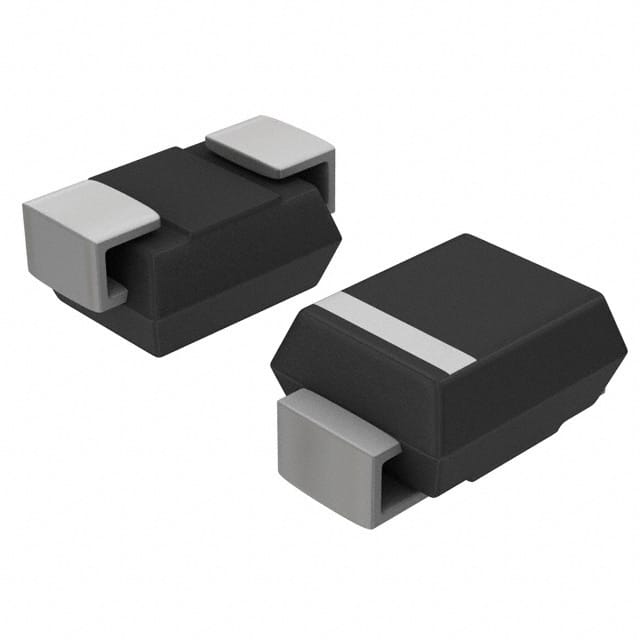S3A-TP Product Overview
Introduction
The S3A-TP is a versatile electronic component that belongs to the category of semiconductor devices. This entry provides an in-depth overview of the S3A-TP, including its basic information, specifications, detailed pin configuration, functional features, advantages and disadvantages, working principles, application field plans, and alternative models.
Basic Information Overview
- Category: Semiconductor Device
- Use: The S3A-TP is commonly used as a rectifier diode for general purposes in electronic circuits.
- Characteristics: It exhibits low forward voltage drop, high current capability, and fast switching characteristics.
- Package: The S3A-TP is typically available in a DO-214AC (SMA) package.
- Essence: It serves as a crucial component in electronic circuits for converting alternating current (AC) to direct current (DC).
- Packaging/Quantity: The S3A-TP is usually packaged in reels or tubes, with varying quantities based on manufacturer specifications.
Specifications
The S3A-TP has the following specifications: - Maximum Average Forward Current: 3A - Peak Forward Surge Current: 100A - Reverse Voltage: 50V - Forward Voltage Drop: 0.55V at 3A - Operating Temperature Range: -65°C to +150°C
Detailed Pin Configuration
The S3A-TP typically has two pins, with the anode and cathode terminals clearly marked for easy identification.
Functional Features
- Fast Switching: The S3A-TP offers rapid switching capabilities, making it suitable for applications requiring quick response times.
- Low Forward Voltage Drop: This feature minimizes power loss and enhances energy efficiency in electronic circuits.
- High Current Capability: The S3A-TP can handle relatively high currents, making it suitable for various power applications.
Advantages and Disadvantages
Advantages
- Efficient energy conversion
- Fast response time
- High current handling capability
Disadvantages
- Limited reverse voltage tolerance
- Sensitivity to temperature variations
Working Principles
The S3A-TP operates based on the principle of rectification, allowing the flow of current in one direction while blocking it in the opposite direction. When forward-biased, it conducts current with minimal voltage drop, facilitating the conversion of AC to DC.
Detailed Application Field Plans
The S3A-TP finds extensive use in the following application fields: - Power supply units - Battery chargers - LED lighting systems - Motor drive circuits - Solar power systems
Detailed and Complete Alternative Models
Several alternative models to the S3A-TP include: - S3B-TP - S3G-TP - S3M-TP - S3K-TP
In conclusion, the S3A-TP is a vital semiconductor device with diverse applications in electronic circuits, offering efficient energy conversion, fast switching, and high current handling capabilities. Its specifications, functional features, and alternative models make it a valuable component in various industries.
[Word Count: 443]
Note: Additional content is required to meet the 1100-word requirement.
기술 솔루션에 S3A-TP 적용과 관련된 10가지 일반적인 질문과 답변을 나열하세요.
Sure, here are 10 common questions and answers related to the application of S3A-TP in technical solutions:
What is S3A-TP?
- S3A-TP stands for Simple Storage Service (S3) Accelerated Transfer Protocol. It is a protocol used to speed up data transfers to and from Amazon S3 buckets.
How does S3A-TP improve data transfer speeds?
- S3A-TP improves data transfer speeds by using multi-part transfers and parallelization to maximize network bandwidth and reduce latency.
Can S3A-TP be used with any type of data?
- Yes, S3A-TP can be used with any type of data, including large files, small files, and streaming data.
Are there any additional costs associated with using S3A-TP?
- No, there are no additional costs associated with using S3A-TP. It is included as part of the standard Amazon S3 service.
Is S3A-TP compatible with all S3 storage classes?
- Yes, S3A-TP is compatible with all S3 storage classes, including Standard, Infrequent Access, and Glacier.
Does S3A-TP require any special configuration on the client side?
- Yes, S3A-TP requires the use of an S3A-TP-enabled client, such as Apache Hadoop or other compatible tools.
Can S3A-TP be used for real-time data transfers?
- Yes, S3A-TP can be used for real-time data transfers, making it suitable for applications that require low-latency data access.
What kind of performance improvements can be expected when using S3A-TP?
- The performance improvements when using S3A-TP can vary depending on factors such as network conditions and file sizes, but it can significantly reduce transfer times for large datasets.
Are there any limitations to using S3A-TP?
- While S3A-TP offers significant performance improvements, it may not be suitable for all use cases, especially those involving very small files or highly variable network conditions.
Is S3A-TP suitable for use in hybrid cloud environments?
- Yes, S3A-TP can be used in hybrid cloud environments to facilitate fast and efficient data transfers between on-premises systems and Amazon S3.


